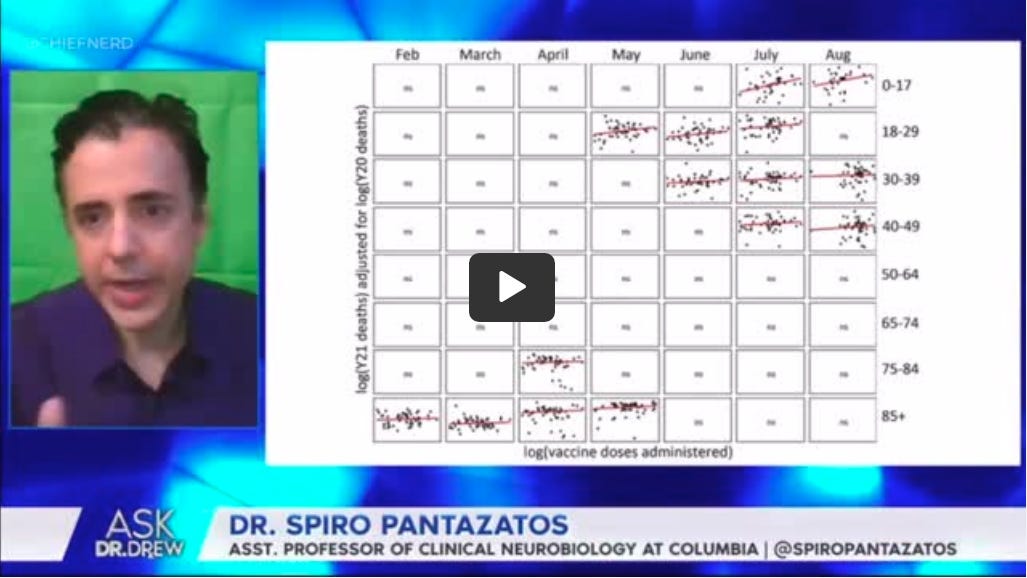Dr. Spiro Pantazatos co-authored a study on mRNA-induced fatality rates: data that he says has been suppressed by most major publications and journals.
One-time or recurring donations can be made through Ko-Fi:


By Miranda Sellick October 20, 2022
At the outset of the pandemic, Dr. Spiro Pantazatos, a clinical neurobiologist and researcher at Columbia University (on leave), vowed he would stay in lockdown until a vaccine was available. He was a believer. But then he began to question the story being told. Next, he studied the data.
Dr. Pantazatos has found a clear link between the rollout of experimental mRNA vaccines and excess mortality numbers. While life insurance companies began screaming from the rooftops in the late spring of 2022, Dr. Pantazatos was well ahead of the game, producing a paper that demonstrated this link in October 2021. But nobody wanted to read his findings, and no medical journal would publish the paper. “It was diplomatically rejected by many editors at medical journals,” he told Dr. Drew in his eponymous podcast.

Dr. Pantazatos’ paper comes to a simple conclusion using publicly available data; the more vaccines administered, the higher mortality observed. “The number of deaths in each state correlated with the number of vaccinations administered in the previous month,” he said.
However, a basic tenet of data comparison and scientific research says that correlation does not mean causation. In this case, it gave medical journals the opportunity to dismiss his findings by saying that nobody knew if it was the vaccines causing these mortality spikes. But Dr. Pantazatos subsequently cross-referenced his data with that of VAERS deaths, which only strengthened his conclusion that vaccines and excess mortality are linked. His data show that in February, March, and April of 2021, excess mortality was only statistically noticeable in the older age groups. It was not until May that you start to see this in younger age groups,” he said. “The fact that this pattern emerged from the data indicated to me that this is a real signal because that matches the temporal rollout.”
Nobody wanted to know. “When I first had these findings, I thought I had to get it to The Lancet immediately as they have a rapid publishing arm and even in-house statisticians. But they rejected it.” Dr. Pantazatos appealed, explaining that it wasn’t your usual covid submission. “I thought they’d want to get the information out there before the first booster shots.”
Dr. Pantazatos still has no explanation for the continued stonewalling of his findings. He suggests many reasons, including a conflict of interest between scientific journals and big pharma and the possibility that he was just too far ahead of the curve. “At the time, it was too against what everyone was saying. I think the journals have a fear of retraction. They were acting under peer pressure and had a fear of publishing something that was so different in its conclusions.”
But that argument no longer holds water. A cursory scratch at the surface of the vaccine-will-save-us-all narrative shows that for every one hospitalization avoided, there are 4.3 serious adverse events; that after five months, the vaccines have negative efficacy. In other words, they make recipients more susceptible to the virus, not less. That the known risk of myo- and pericarditis for young men now outweigh any benefits; that the vaccine does not prevent transmission and was never tested to do so, confirmed recently by a Pfizer executive to a committee of the European Parliament. And still, Dr. Pantazatos’ paper remains unpublished in a scientific journal.
On the strength of his findings, Dr. Pantazatos launched a petition letter to the administration at Columbia University on the subject of the vaccine mandates being imposed on faculty and students from September 2021 “to help raise awareness,” he says. “I implored them not to trust public health agencies and asked them to rely on global data.” He even attached 140 citations to support the data. He tried to meet with administrators; however, he has not succeeded in doing so. Mandates remain in effect; he is officially non-compliant and remains on leave.
“I think a lot of people in power had to make difficult decisions, and they genuinely thought a mandate would bring people back to campus,” he said. But there’s no longer any excuse for that position. “It’s the same arrogance that makes people think they can make medical choices for people they have not met.”




